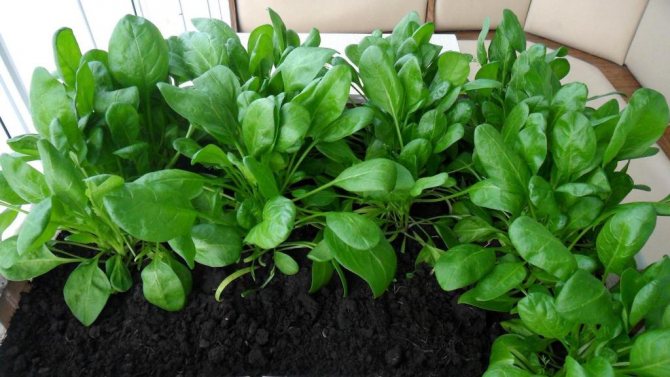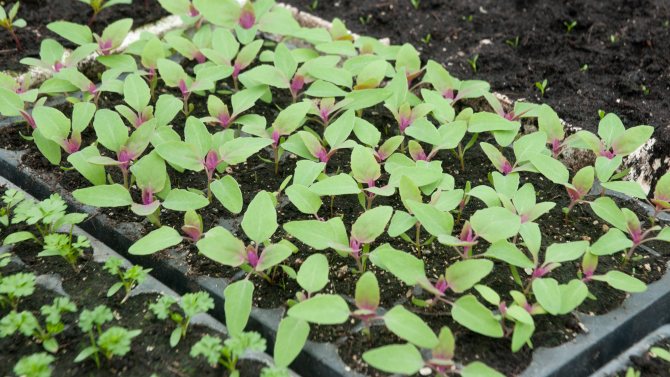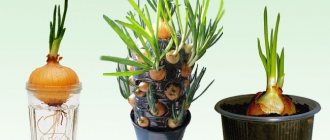Usually, spinach is grown outdoors, but in order to get useful macro- and microelements even in the middle of winter, many sow spinach seeds at home and grow on a windowsill. If you can observe the easy rules of sowing and maintenance (create the necessary light and temperature conditions), then you will have fresh and juicy greens all year round, even if you do not have a summer cottage.
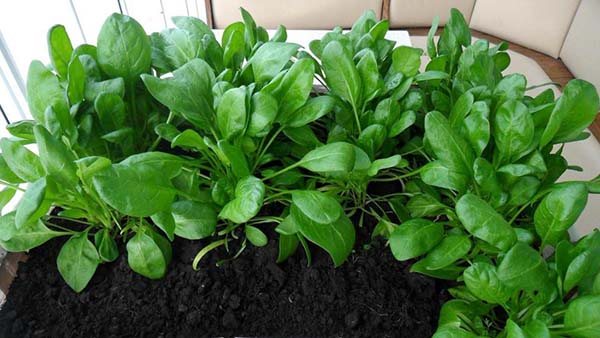
Which spinach varieties are suitable for growing on a windowsill
Before you start growing spinach on a windowsill, you should purchase high-quality planting material. And for this, first of all, carefully study the instructions on the package - familiarize yourself with the characteristics of the varieties in order to choose the most suitable for indoor growing.
As a rule, the following spinach varieties are used for sowing, which perfectly tolerate greenhouse conditions and give a bountiful harvest:
- Fatty.
- Gigantic.
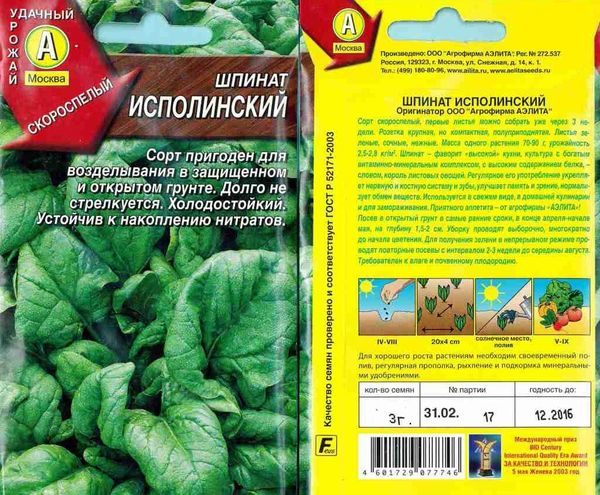

- Matador.
- And also many others, for example, Krepysh, Virofle, Stoic, Victoria, Ilya Muromets. There is even a very interesting strawberry spinach.
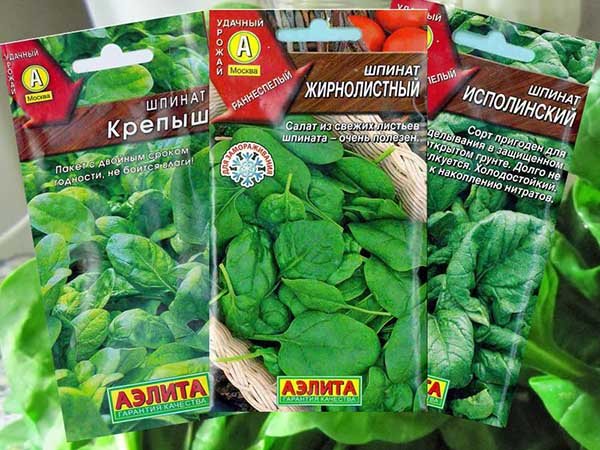

To determine the most suitable variety, it is worth planting several packages of seeds in different containers. Only after that you can understand which kind of spinach will suit you best by all criteria.
Benefits of spinach for women
Spinach is not known to many and is not popular. But this plant has many beneficial properties. After reading them, many women will be interested in how to grow spinach on a windowsill.
Spinach contains a huge amount nutrients... They help promote health. But this leafy vegetable is especially useful for those who dream of losing weight. It's no secret that it is women who are more often concerned about the problem of excess weight. In this case, the introduction of spinach into the diet will help get rid of a few pounds. This is provided by several properties of the product.
- Spinach leaves are rich in fiber, which collects waste in the body and removes them. Thanks to this, the work of the digestive tract is normalized, which leads to weight loss.
- Low calorie content makes the product ideal for those looking to lose weight.
- A mild laxative effect detoxifies the body.
- Spinach helps improve muscle definition. It contains substances that emphasize the muscles, in addition, there are components that accelerate the recovery of muscle tissue.


All these properties are useful not only for women, but also for men. Spinach is ideal for people who care about their figure.
How to plant spinach on a windowsill: features, conditions and step-by-step instructions
After the required variety has been selected, sowing work should be started, namely: preparing the container, soil for growing, soaking the seeds. To do this, planting spinach at home requires a competent approach and performing all stages of growing according to certain rules.
Growing container
The root system of spinach, for example, unlike sorrel, is rather shallow, so a small depth is required.
By the way! Many people dislike spinach because it tastes like grass by grass (not sour like sorrel). Indeed, it is a tasteless plant.But a neutral taste is gorgeous, you can make such delicious dressings! For example, Caesar salad with spinach turns out to be very unusual.
Naturally, the pot must have drainage holes for excess moisture to drain out.
In addition, a small layer of expanded clay or foam should be laid out at the bottom of the planting tank as drainage.
What soil to plant
Spinach will only grow well in neutral soil.
In other words, spinach loves soil. with an acidity level of about 6.5-7 pH!
You can purchase ready-made soil for growing vegetables such as cabbage, pumpkin, beans, peas.
Or cook it yourself. To do this, take a neutral garden soil and mix it with compost or humus, as well as river sand.
Advice! Any soil, even purchased, is recommended to be disinfected beforehand, for example, by frying it in the oven, so that all pathogenic organisms and fungi die under the influence of high temperatures. And / or spilling with potassium permanganate solution or phytosporin.
Presowing seed preparation
Planting spinach with dry, unprepared seeds is not recommended (unless it is coated, i.e. already processed seeds). The seeds have a dense outer structure, so they should be pre-soaked for a day or two in water at room temperature (above 18 degrees).
And then (if desired) hold for another 20-30 minutes in a weak solution of potassium permanganate to disinfect the seedlings from diseases.
Direct landing
Step-by-step instructions for sowing spinach seeds for further cultivation at home:
- Drainage, soil is poured into the planting tank.
- Barbs are made with a depth of 1.5-3 cm.
- The seeds are sown at a distance of 2-3 centimeters from each other.
- Next, you need to fill the rows with soil.
- Carry out its (soil) moistening. For example, you can spray from a spray bottle.
- To create greenhouse conditions, the container is covered with foil or glass.
- The pot is placed in a warm (+18 .. + 20 degrees) and dark place.
- When shoots appear, the shelter (greenhouse) is removed, and the container itself is rearranged in a bright place - on the windowsill.
Note! In the next video, the author uses unsuitable ground for growing spinach (not that acidity). In general, everything is shown very well and clearly.
Video: sowing spinach seeds for growing on a windowsill
The soil
A window sill is a great place to breed spinach in a room. Housewives do not have to spend a lot of time and effort to grow it.
In the summer and spring months, when planting seeds, you do not need to resort to an artificial light source, but in the autumn-winter period, you must additionally turn on the lamps. The duration of daylight hours in the cold season should be at least 10 hours. On cloudy days, it is also required to turn on artificial light for the growth of young shoots.
As a container for sowing seeds, you can use plastic or wooden flowerpots 15-20 cm high. Seeds must be planted at some distance from each other. Shallow furrows are made in the prepared soil and watered with water.
Ready-made soil mixtures used for flower crops can act as a nutrient substrate. They do not contain peat, which oxidizes the soil. However, the best option would be to prepare the soil yourself. To do this, it is necessary to mix one part of vermicompost and two parts of coconut fiber, which prevents the soil from drying out and prevents water stagnation.
It is necessary to pour a small layer of expanded clay into the container for planting, which will act as a kind of drainage. If there are difficulties with the acquisition of coconut fiber, then you can use only vermicompost.From time to time you need to add 1-2 teaspoons of perlite or vermiculite to it, which have the same properties as coconut fiber. These additives ensure the preservation of the soil mixture and protect it from rotting.
We suggest that you familiarize yourself with: Recipe for cold salting of whites. Recipes on how to hot and cold salt whitewash mushrooms in jars for the winter. Salting whites without heat treatment
The land for a good harvest should be fertilized and loose. For best results, you can prepare the soil yourself. You need to take garden soil and humus, then mix in arbitrary proportions and place everything in the oven for at least half an hour. Such a procedure will completely destroy all pests and pathogens.
There is also an easier option - the acquisition of soil, which is intended for seedlings. However, it is necessary to take only a non-acidic type of soil (no peat). Peat oxidizes the soil, and this does not favorably affect the development of the plant.
Transferring spinach from open ground to a pot for growing in an apartment
By the way! It is not necessary to grow spinach from seeds, it is much easier to take and transplant it from the garden.
All that is needed is to dig in the bushes in the fall and transplant them into a pot.
Further, care and cultivation are carried out in the same way as sown with seeds (more details below).
Video: spinach on a windowsill in winter (results after transplanting a bush from open ground)


In modern apartments, amateurs have learned to grow various herbs: rucola, basil, parsley, onions, herbs. But is it possible to grow spinach on a windowsill, providing yourself with valuable vitamins all year round? This article will answer this question.
Spinach is an annual plant used for food. It is famous for its rich content of vitamins and minerals. The first mentions of culture appear in the literature of Italy in the 15th century. In Russia, it appeared on the tables of monarchs from the middle of the 18th century, and for a long time remained an uncommon "master's vegetable".
Planting instructions for spinach
You can pick up the seeds yourself by picking ripe spinach berries, grind them in mashed potatoes. Berry porridge is mixed with water and stands until fermentation, after which the seeds are removed from it and dried. The finished seeds, the cultivation of which is planned by the gardener, are simply soaked.
Planting material is sown into wet soil, without deepening by more than 10 mm. The box is wrapped in plastic wrap until sprouts appear. The earth is watered from time to time as it dries.
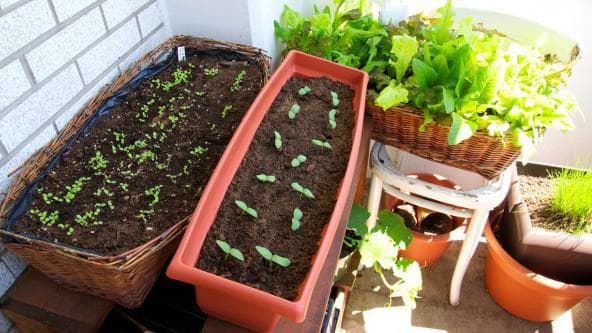

After the seedlings appear, the film is removed, and watering goes into normal mode. When 4 leaves appear on the plants, they are transplanted into individual containers.
Spinach is very scrupulous about watering: it should not be poured, then it should not be dried. If the plant is poured, mold will quickly develop in the pot and the roots will start to rot. A drainage layer can be used to regulate the moisture in the pot.
If the greens are watered a little, then the leaves begin to harden, becoming tough and tasteless. At low humidity in the room, it is recommended to spray with a spray bottle.
Application of spinach
Spinach is a leafy vegetable. One of the amazing properties of the plant is that it practically does not lose its properties after heat treatment. Therefore, products after cooking and freezing are still useful.


Juicy leaves are put in soups, vegetable dishes, and mashed potatoes for babies are made from them. Greens can be frozen, which will extend their useful life.
Interesting facts about spinach
- Spinach is popular in different countries. Many national cuisines consider it to be the basis.
- This amazing leafy vegetable has many vitamins, trace elements, antioxidants. It is widely used in dietary nutrition.
- 100 g of fresh spinach contains ¼ of the daily diet of iron, 4 times the daily value of vitamin K.
- In French cuisine, it is called the "stomach broom" - it perfectly cleanses the intestinal tract.
- Spinach is rich in fiber, providing a feeling of fullness.
- Fresh herbs ideally complement meat, fish dishes, chicken eggs. When frozen, it is used in pasta, rice, soups and even baked goods.
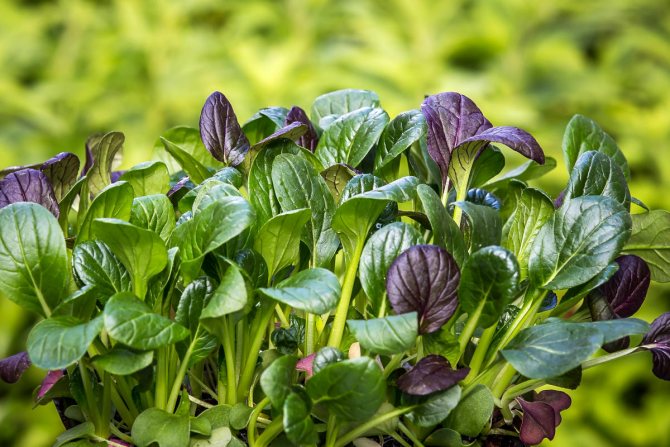

Spinach is a delicious and healthy leafy vegetable. Grow it in your own summer cottage, settle it on your windowsill, and you can always have fresh and healthy greens.
Home-grown spinach varieties
Seed selection will not be difficult. Specialized shops offer a large selection of seed material. It is only necessary to carefully study the planting instructions in order to choose early or mid-season varieties that are most suitable for cultivation in an apartment.
Fat-leaved
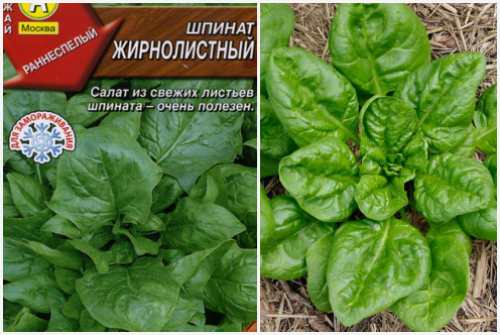

An early ripe variety, ready for cutting in 28 - 30 days. The leaves are slightly bubbly, juicy, tender.
Sturdy


Reaches marketable maturity in 30 days. The variety is high in protein, vitamins and minerals. The outlet is large, weighing up to 90 grams.
Gigantic


From the moment of germination to harvest, 20 - 25 days pass. Slightly bubbly large leaves of light green color, very juicy and tender.
Marquise
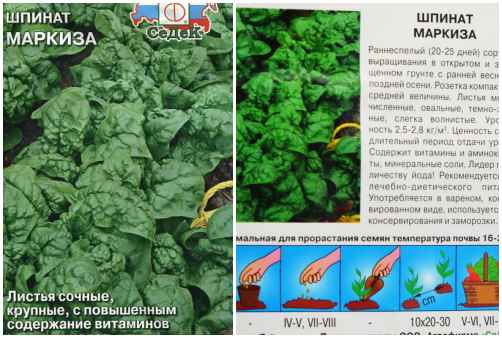

An early ripe variety, the first harvest is removed after 20 - 25 days. It is famous for its long fruiting period. Leaves are numerous, slightly wavy.
Variety selection
When choosing a variety, give preference to early maturing. And the rosettes of the plant should not be large in diameter, because then they will need a large area. Suitable varieties for growing on a windowsill:
- Godry. Early variety, ripens quickly. It will be possible to feast on the leaves three to four weeks after their shoots. The rosette is 20-25 cm in diameter.
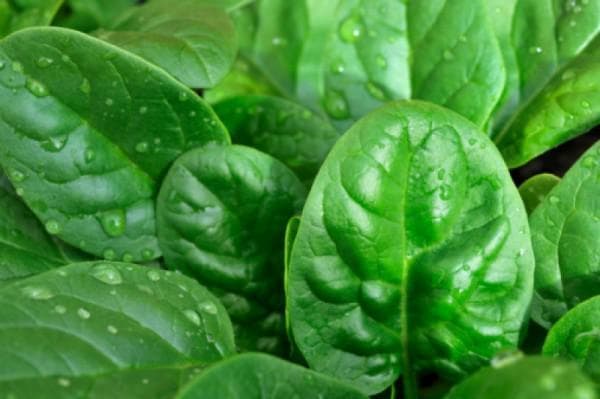

- Gigantic. The variety is early, early maturing. After sowing it, you will be with spinach in two to three weeks after germination. The size of the rosette is from 10 to 50 cm (depending on the fertility of the soil).


- Virofle. An early ripe variety, it grows to technical maturity in 20-25 days from germination. Rosette up to 30 cm in diameter.
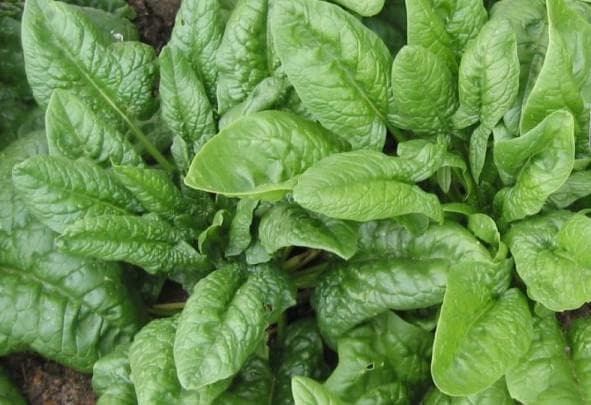

In addition to the above, the varieties "Victoria", "Melody", "Tarantella" are also suitable.
When purchasing seeds, pay attention to the timing! Spinach seeds are suitable for 3-4 years. Fresh or last year's are considered the best for sowing.
How to grow spinach on a windowsill
Growing spinach at home on a windowsill is a little more difficult than forcing other greens. Compared to simple crops, it is more picky about growing conditions. Therefore, in order to obtain a good harvest, it is necessary to create an environment that is as close to natural as possible.
Lighting
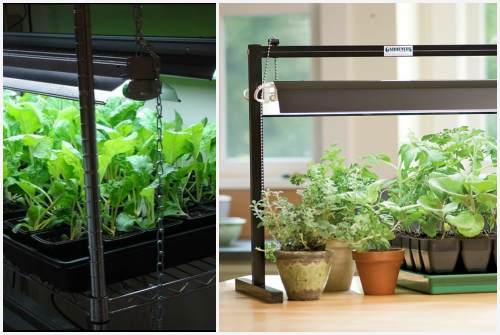

The main reason for failing spinach growing in winter is lack of lighting. Plants stretch out, the leaf mass turns out to be rare and faded, its quality suffers. The best way out of this situation is to use a backlight with lamps of a vegetable spectrum. In their absence, ordinary fluorescent lamps will come in handy.
We wrote about phytolamps for plants in this article.
The soil
The culture is not demanding to the composition of the soil, a universal soil mixture or garden soil, with the addition of compost and sand, is suitable. A small condition - it is not advisable to use peat, since the plant does not like acidic soil.
Planting containers
Spinach thrives in seedling boxes, at least 12-15 cm deep or in flower pots. Drainage holes are required. Pebbles, broken brick, expanded clay are used for drainage.
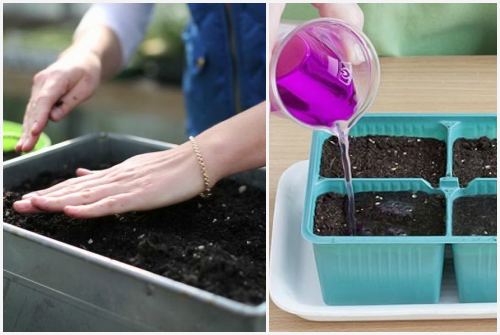

For beginners, spinach is not the easiest crop to grow, but compliance with the above simple conditions will allow even a beginner to grow a good harvest.
Landing
Stages of sowing spinach seeds:
- A drainage layer of broken brick or expanded clay is laid in the prepared container.
- The treated soil mixture is poured onto the drainage.
- Spinach seeds are buried 1–2 cm in the ground.
- All plantings are covered with soil.
- Immediately after sowing, the soil is slightly moistened. This will make the entries appear faster.
- The box is covered with plastic wrap or a transparent lid and moved to a bright place.
Advice! When planting seeds in a common pot, it must be borne in mind that each plant needs at least 8-10 cm of soil for normal development.
Growing spinach from seeds
Before planting, the seeds can be soaked, this will speed up the emergence of seedlings, they will be more friendly.
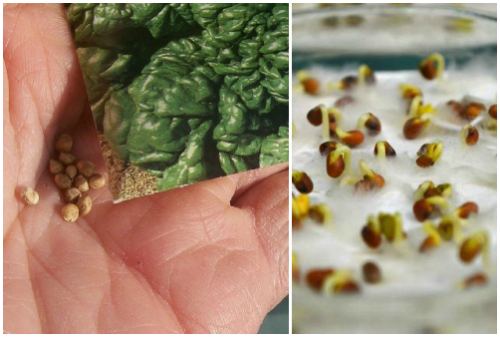

- Seeds are planted in rows, at a distance of 5 cm from each other, it is possible and more often, but then thinning will be required. Embedding depth - 1 - 1.5 cm.
- The surface of the soil is slightly moistened, cover the top with glass or a transparent wide container until shoots appear.
- After the first shoots appear, they are immediately placed under the lamps. The backlight is made at least 12 hours a day.
- The favorable temperature for growing leaf mass is about 16 -19 C.
- When 4 - 5 true leaves grow, young plants are planted in individual pots. You can leave them in the same container, but in this case they are thinned out, leaving 15 - 20 cm between the bushes.
- Water the seedlings regularly, without stagnating water.
Seed breeding
Varieties differ in sowing time, leaf size and taste. Experienced vegetable growers recommend growing early maturing varieties at home that tolerate greenhouse conditions well. The most suitable are:


Gigantic. The rosette consists of medium sized leaves. Ripens in a month from the moment the first shoots appear. It has a delicate taste and is recommended for feeding children.- Stoic. It has medium-sized leaves. The period from germination to technical maturity takes 14–20 days.
- Fatty. It is characterized by fleshy leaves with a relief coating. Ready to harvest 35-40 days after the first shoots appear.
- Victoria. Rounded leaves form a compact rosette. An early ripening variety, ripens in 25–40 days.
- Strawberry. Ready to eat two to three weeks after the first shoots appear. Not only are the leaves edible, but also the fruits.
If spinach is grown for the first time, it is recommended to plant several varieties of seeds.
Before planting, the seeds must be soaked in warm water for a day. The procedure will speed up the germination process and increase the percentage of seed germination. After soaking, place the planting material for two to three hours in a weak solution of potassium permanganate for disinfection. Then remove and pat dry with a paper towel.
- Prepare the soil and container.
- Calcine the soil in the oven for about half an hour, or treat it with a solution of potassium permanganate.
- Pour drainage on the bottom of the pot - expanded clay or pebbles.
- Place the treated substrate on top.
- On the surface, make small grooves up to one and a half centimeters deep.
- Arrange the seeds in the grooves, leaving gaps of two to three centimeters.
- Sprinkle with a little earth.
- Moisten the soil slightly with a sprayer.
- Cover the container with glass or plastic wrap.
- Keep in a warm place.
- When the first shoots appear, remove the shelter. Usually the first shoots appear in a week and a half after sowing.
Do I need to overseed?
After harvesting the first harvest, it is recommended to sow new seeds in the vacant space. This measure ensures the continuous growth of the greenery.
Diseases and pests
Most often, the culture is affected by fungal diseases that cause root and stem rot. Outwardly, the disease is manifested by the appearance of brown spots on the leaf mass. With root rot, the base of the rosette and roots are affected. Withering occurs, the growth of the plant is delayed.
Causes of fungal infections:
- Poorly disinfected garden and compost soil containing fungal spores.
- High soil moisture with poor drainage.
- Thickening of plantings.
- A combination of the above factors and high temperature (above 18 - 20 C) of the ambient air.
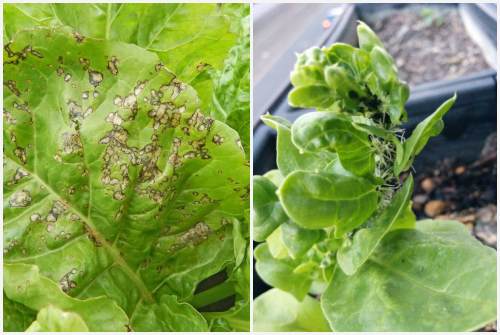

Viral diseases
Viruses cause leaf mosaicism and curliness. In addition to external defects, there is a deterioration in growth, oppression of the plant, and dwarfism.
Insect pests
In an apartment, aphids can attack the leaves. Due to the fact that greens grow very quickly and are used for food, the use of chemicals should be excluded. The best and safest option is to manually remove the insects or rinse them off with a shower.
Growing problems
If the seedlings are stretched out, then you need to increase the amount of light. It is better to move boxes from north, east and west windows to south or install a lamp for additional lighting. If spinach develops extremely slowly, the sprouts have small and weak leaves, then fertilizer should be added to the soil.
Diseases of spinach seedlings:
- Fusarium is a fungal disease. It manifests itself as a darkening of the leaves and a cessation of their growth. The lower leaves turn yellow and die off.
- Anthracnose - brown or grayish spots caused by a fungus.
- Root rot is another fungal disease that affects mainly young plantings. It appears as spots with a fungal formation in the center.
If the fungus has infected a small part of the plant, then it is removed, and the seedlings are treated with a fungicide solution. If most of the spinach is damaged, it is best to dig it up and plant new seeds.
Important! The leaves of the affected plant are not edible! They need to be thrown away.
Seedling pests appear only in open ground; they rarely settle on room seedlings.
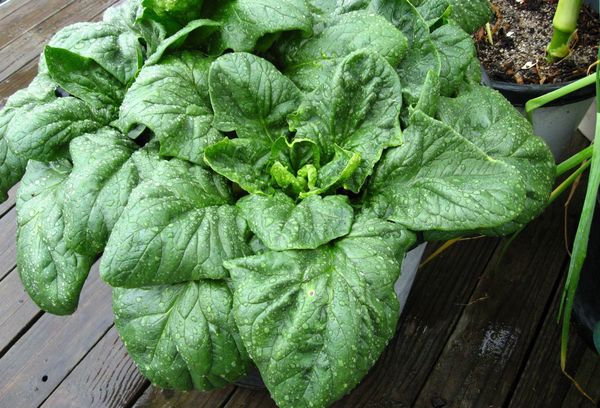

Examples of pests:
- caterpillar scoops,
- aphid,
- bear,
- beet fly.
To expel the pest from the plantings, the bed is treated with a solution of the substance anabazine sulfate: for 10 liters of water - 15 cm3.
Control measures, prevention
When the first signs of the disease appear, the plants must be carefully examined.
- Sick seedlings are removed entirely, if the lesion is insignificant, then spotted leaves are removed.
- Thinning is carried out, leaving 10 - 12 cm between the sockets.
- Provide good drainage.
- Before planting, warm up the soil well to disinfect it.
- Water the seedlings with a solution of Fitosporin or potassium permanganate.
- Do not reuse the same land.
- If there are signs of a virus attack, the bush is removed completely.
The most reliable prevention against damage by diseases and pests is adherence to planting rules and growing conditions.
Storage
Fresh spinach can be stored for 5-7 days at temperatures between 0 and +1. If the leaves are placed in the refrigerator, they are wiped dry.
Advice! The sooner the torn leaf is eaten, the more benefit it will have for the body. Long-term storage of greens loses valuable substances.
To preserve the crop for a long time, it is dried, frozen or canned:
- For freezing, the leaves are washed, dried, the roots are cut off. Spinach is frozen whole or sliced. A good option is to blanch the herbs (pour over with boiling water) before moving to the freezer.
- Spinach leaves are also stored as mashed potatoes: they are washed, immersed in a blender and chopped.
- The spinach crop is dried in a shaded dry place, preferably outdoors. After a few days, the leaves are transferred to tissue bags and sent to storage.
- Salting is not the most popular way to prepare spinach. Peeled leaves are placed in jars and sprinkled with salt. The product is stored strictly in the cold and for a short time.
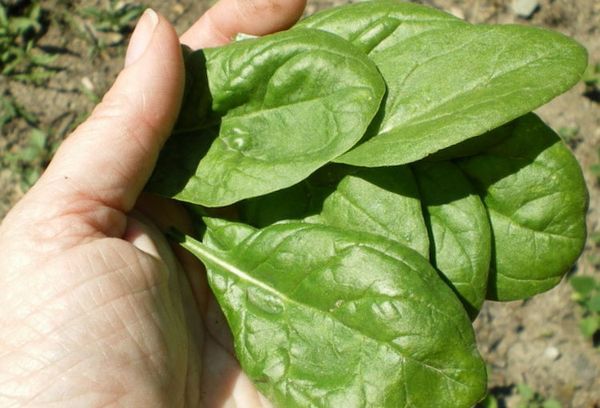

Is it possible to grow spinach on a windowsill in winter
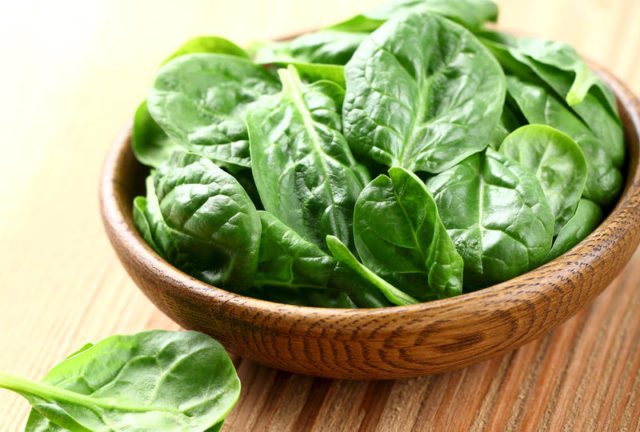

Usually they practice growing greens in the open field or in a greenhouse in the warm season, but spinach on the windowsill in the cold season is not uncommon.If you follow the simple sowing rules and create favorable home conditions for plant growth, greenery on the windowsill can be grown all year round. For this purpose, windows or glazed balconies facing the south side of the house are suitable. Although if you provide the plant with additional lighting, it is possible to grow greenery on the windowsills of windows facing north.
Why spinach is good for you
Spinach is useful not only fresh, but also as a winter preparation. This green is a source of fiber, vitamins A, B, C, E, K, P, PP, trace elements (iron, potassium, magnesium), organic acids, flavonoids and vegetable protein.
Spinach is useful for children as a preventive measure against rickets, has a positive effect on stomach health, stimulates the intestines, improves blood composition and much more. Spinach saturates the weakened body with vitamins and is an integral part of the dietary menu.
If you want to easily grow a healthy and cute plant, then there is no better option than spinach bushes. The greenery of this plant enlivens the room, looks neat on the site, and most importantly, it is a tasty and valuable product for health.
Which spinach varieties are suitable for growing on a windowsill
Growing spinach at home is usually practiced from early maturing varieties. The most popular among fans of growing spinach on the windowsill are the following:
- Fat-leaved is an early ripening variety that ripens for 30-35 days. Has a small rosette reaching 17-28 cm in diameter;


- Strawberry - with a mild strawberry aroma, early, fast-growing, does not require special care; its berries, which outwardly resemble raspberries, are also consumed, thanks to this the variety is distinguished by additional decorativeness;


- Virofle is also an early variety and the crop can be harvested as early as 20-25 days. The neat rosette reaches 30 cm in diameter.


In addition to the above, you can grow spinach at home with seeds of the varieties Victoria, Matador, Melody, Krepysh, Gigantic, Stoic, etc.
Features of growth and development
Spinach belongs to the long day plant group. This means that it needs continuous and intense lighting for full development and flowering.
He can easily tolerate low temperatures. Seeds are able to germinate already at a temperature of 4 degrees. In hot climates, the plant enters the flowering phase. Overripe leaves already have an unpleasant taste.
Spinach has a high yield, which is achieved in a short period of time. 40 days after the appearance of the first shoots, you can get a batch of finished quality products.
Good yields are ensured when growing crops in fertile soil that has a slightly alkaline or neutral environment.
This plant needs constant soil moisture, but an excessive amount of water can be detrimental. When growing spinach at home, you need to observe certain parameters of indoor air humidity.
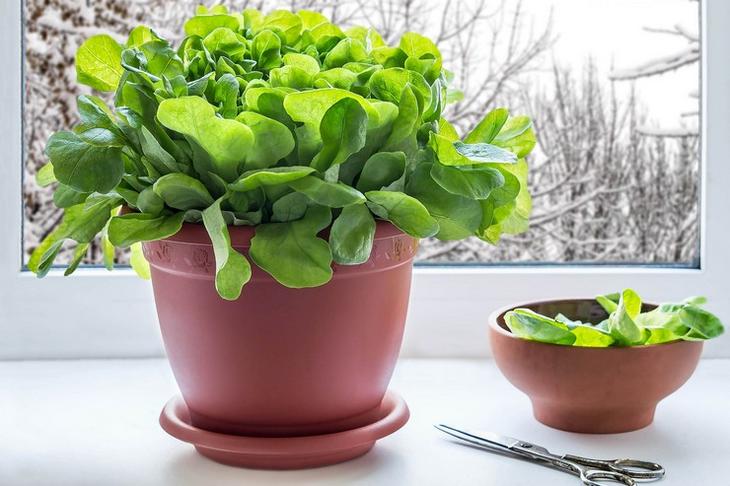

In the first period, spinach does not differ in abundant growth. Only 20 days after the emergence of shoots, the plant forms rosettes and its growth is rapidly increasing. During the growing season, the plant manages to give up to 5 harvests. The leaves are cut every week. In the case when it is necessary to provide the family with fresh juicy greens, it is recommended to sow plants at intervals of several weeks.
What conditions need to be created
To grow spinach on a windowsill in winter, it is necessary that the plant does not lack light, feeding and watering. In addition, the soil must be loosened regularly.
It is especially important to pay attention to the temperature regime. The plant is quite cold-resistant, so you should not put it on a windowsill with a battery.The plant feels most comfortable at +15 - 18 ° C, so growing it at home on a glazed balcony is an excellent solution. If there is no balcony, it is better to rearrange the pots to the western and northern windows of the house in winter, and to the southern and southeastern windows in summer. At a temperature of +25 ° C, spinach begins to shoot arrows, which is to the detriment of greenery, since after the appearance of peduncles, the leaves become tough and unsuitable for food. It is best to practice growing spinach on the windowsills of kitchen windows, since the humidity in the kitchen is much higher than in the room. In addition, the kitchen often has to be ventilated, which will provide suitable conditions: spinach feels good in a draft.
Spinach does not tolerate the scorching rays of the sun, therefore, on especially hot days, sowing and growing young greenery at home is not recommended, especially if all the windows in the apartment face south. If, nevertheless, the desire to grow the culture of the house is stronger, the bushes should be shaded without fail so that the leaves do not fade. In addition, direct sunlight degrades the palatability of the herbs, making them bitter.
This is also important because spinach under dry conditions accelerates the appearance of arrows, so it is useful to spray the plants with a spray bottle every day or bathe them once a week under the shower.
What should be the lighting
To grow spinach at home on a windowsill, you must first pay attention to proper lighting. This plant, like all the others, is quite light-loving and in the absence of proper lighting it can simply wither away, then a good harvest is out of the question.
The ideal option for spinach would be to grow it near a south-facing window. If this is not possible, then additional lighting must be created.
The best quality lighting items are fluorescent lamps or phytolamps. It is necessary to install these devices at a height of 60 cm, do not neglect this rule, since it is this distance that will give the plant the necessary light.
It is worth considering the fact that spinach needs at least 10 hours a day of good lighting for good growth. Therefore, the factors of the season should be taken into account. For example, in winter it brightens and darkens earlier, so additional lighting must be turned on for at least 4 hours a day. If the weather is cloudy outside, then the fluorescent lamps should work all day.
Rules for growing spinach from seeds on a windowsill in winter
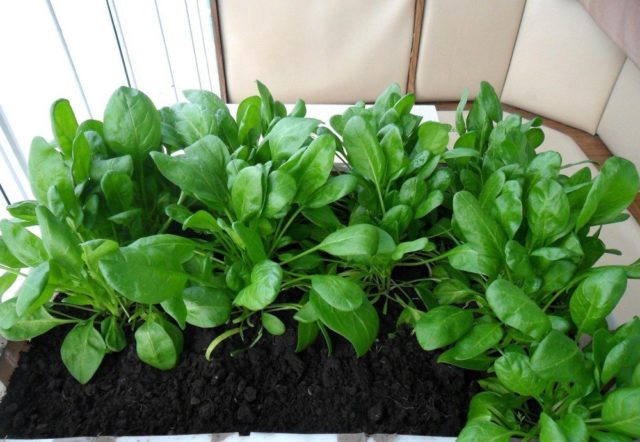

Growing spinach from seeds at home should start with the preparation of planting containers, soil, and planting material.
Preparation of containers and soil
Growing spinach is possible both in ordinary flower pots (ceramic or plastic) and in wooden boxes approximately 20 cm high. It is important that the container has drainage holes. For full development, an adult plant needs 8x8 cm - this is exactly the planting scheme that should be followed when sowing seeds in boxes. If cultivation is planned in pots, a container of at least 2 liters in volume should be selected and planted with 2 - 3 plants in each. Pebbles, broken brick or expanded clay are used as drainage, with which the bottom of the planting container is covered with a layer of 3 cm.
It is not permissible to grow this vegetable crop in acidic soils. Spinach growing at home feels most comfortable in neutral soil. You can buy a ready-made substrate (universal soil for seedlings, without peat, which promotes oxidation) or you can prepare it yourself from the calculation: two parts of garden soil, one part of humus and one part of sand.
The earthen mixture is calcined at a high temperature for an hour to avoid the risk of contamination of the seedlings with fungus and pathogens.For this, the soil composition is poured onto a baking sheet with a layer of 5 cm and sent to the oven. Experts advise subjecting purchased soil to such a procedure as well.
In addition, there are often cases when growing spinach at home is practiced in a mixture of coconut fiber and vermicompost, in proportions of 2: 1, respectively. Coconut fiber retains moisture well, while reducing the risk of moisture stagnation.
Seed preparation
In order to grow spinach at home from seeds on the windowsill in winter, for better germination, they must be pre-prepared in order to soften the rather hard seeded shell. Soaking is carried out for 1 - 2 days in warm water at a temperature of 18 - 20 ° C. It is also recommended to hold the inoculum for 30 - 40 minutes before sowing in a weakly concentrated solution of potassium permanganate or potassium permanganate for disinfection purposes. The pelleted seeds are not subjected to this procedure and are not soaked.
Immediately before sowing, the seeds must be removed from the water and dried on a paper towel.
How to plant spinach on a windowsill
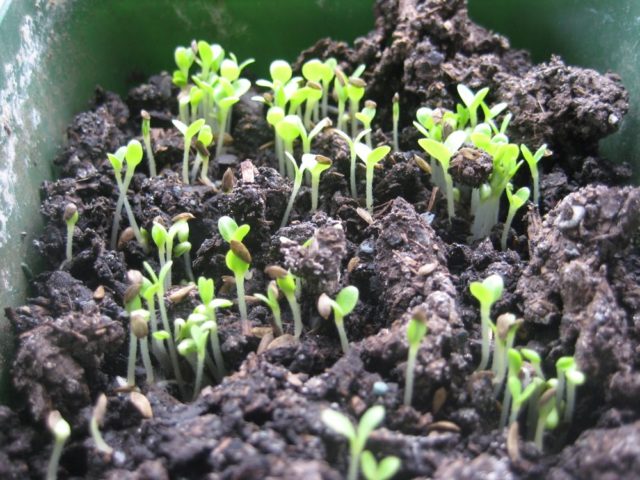

Growing spinach from seeds at home is possible at any time of the year. Before sowing, the soil in the planting containers should be well moistened. Below is a step-by-step guide on how to grow spinach on a windowsill in winter for beginners:
- In planting containers filled with drainage and substrate, grooves are made to a depth of 1.5 cm. There should be at least 8 cm between rows;
- Prepared seeds are sown into the grooves made with a step of 8 cm, after which they are sprinkled with soil;
- After that, the soil is moistened with warm water using a spray bottle, and the planting containers are covered with glass or film to create a greenhouse effect;
- The containers are removed in a warm (18 - 20 ° C) dark place;
- After 5 - 6 days, when the first shoots appear, the film or glass is removed, and the boxes are rearranged on the windowsill.
Fertilizer and soil for spinach
It is recommended to plant spinach on the windowsill in the soil for flowers. The soil should not contain peat, which makes it acidic. The gardener can prepare the mixed soil himself by mixing vermicompost and coconut coir in a ratio of 1 to 2.
The presence of coconut coir in the soil will help retain water in the soil, preventing the soil in the pot from drying out and regulating the moisture and drought balance. The bottom layer of the substrate laid out in the pot should be expanded clay drainage. It is poured 20-30 mm.
If there is no coconut coir, then it can be replaced with vermicompost by adding perlite or vermiculite. We take a tablespoon of the additive for one hundred grams of soil. This mixture will perform the same function as coconut fiber, but will not rot, and therefore it can be used for a long time.
To feed the plant, it is recommended to use ordinary complex fertilizers for flowers. Fertilization occurs every 2 weeks, if desired, you can use liquid fertilizers at home.
It is recommended to soak spinach seeds in warm water for 5-7 hours before sowing to speed up their germination. Before planting the soil, the soil must be watered and wait until the water is absorbed, if you plant the seeds in dry soil and then water, the seeds can be drawn deep into the soil and will germinate for a long time.
After sowing, if necessary, the soil is moistened with a spray bottle, and the container must be covered with plastic wrap or glass. For germination of seeds in the so-called "greenhouse" conditions, after a little more than a week, the first green shoots appear. When the first sprouts appear, the glass or film is removed, and the container with spinach is transferred to a well-lit place.
We suggest you familiarize yourself: How best to freeze zucchini for the winter
How to grow spinach in winter on a windowsill in an apartment
To grow spinach at home and get a harvest of the same quality as in the open field, you should pay attention to regular watering, feed the plants, and arrange lighting.
Watering
Spinach is a moisture-loving plant, therefore watering should be abundant, and the air humidity should be high. With insufficient watering, the greens will begin to wither, which can lead to the death of the entire bush. At the same time, it is important to avoid stagnant water in order to avoid the risk of fungal infection. Young sprouts need to be watered with warm (at least room temperature) water.
In addition, growing a crop at home during the summer requires spraying the plantings from a sprayer once a day (in the early morning or after sunset), and in winter, when the air is excessively dry, twice a day. In order to provide the necessary air humidity on the windowsills, several open containers with water are placed between the boxes or pots. In addition, you can stretch plastic wrap over spinach bushes on a special frame to achieve a greenhouse effect.
Growing spinach at home with insufficient soil or air moisture is fraught with the fact that the greens will be small, tough and coarse. In addition, overdried soil stimulates the release of peduncles.
Top dressing
Spinach should be fertilized only once during the entire growing season - at the time of transplanting seedlings to a permanent place with complex fertilizers for flowers. Organic fertilizers (mullein, chicken droppings) are used as top dressing, but with caution, since their excess affects the taste of the leaves.
Mineral, nitrogen-containing fertilizers should be completely avoided, since spinach greens, especially its petioles, tend to actively accumulate nitrites, which makes them unhealthy.
If spinach is grown in fertile, nutritious soil, the plant does not require feeding.
Lighting
Spinach must be provided with at least 10 hours of daylight hours (optimally 12 - 14 hours) in order to get a high yield. Growing plants at home in the summer does not require additional light: natural enough is enough. In this case, the boxes must be regularly turned 180 ° in order to provide the plant with uniform illumination from all sides. Otherwise, they can form one-sided rosettes with abundant greenery, on the one hand, and meager ones, on the other.
This will not be enough for spinach growing at home on the windowsill in winter, therefore, to meet its lighting needs, a fluorescent lamp, spectral LED or phytolamp is installed above the boxes at a height of 60 cm. In cloudy weather, it should be turned on all day. On a normal winter day, you need to supplement the lighting for at least 4 hours, after the intensity of sunlight outside the window decreases.
Spinach care
You can grow spinach on a windowsill in two ways:
- seeds, in which the seeds are spread directly into flowerpots, where it will constantly grow;
- seedling, in which seedlings are grown in containers, and when two true leaves appear, they dive into separate pots.
Prepared culture seeds are sown to a depth of no more than 1.5 cm in moist soil. For seeding, it is recommended to make shallow rows or make holes with a stick. Cover the seed with soil from above and compact it carefully. From above it is necessary to cover the flowerpots with plastic wrap or glass, forming a primitive greenhouse.
It is very easy to care for the culture. The necessary conditions are - lighting, adherence to temperature conditions and timely watering. The plant feels great with a day of light for at least 10 hours. That is why, when growing spinach in winter, it is necessary to additionally illuminate it with lamps. For such events, traditional fluorescent lamps are suitable.
a stand made of wood or thick foam is placed on the windowsill. During the summer growing season, the plant needs shading from strong sunlight. Spinach is picky about watering. He prefers moist soil without stagnant water.The crop responds gratefully to spraying, especially in hot and dry seasons.
This is why a breathable layer is very important for successful crop cultivation. As a rule, spinach is not fertilized. In the event that the substrate is used again, it is recommended to add organic fertilizer to it.
Temperature conditions. The plant is cold-resistant and not very demanding in this regard: it will rise even at 4, it will not freeze at -5, it will grow and develop well at 8. This temperature is easily maintained in winter on glazed loggias and balconies. It is not necessary to transfer it to the room in small frosts! Spinach feels very good at 15. But an indicator of 25 promotes arrowing and there will be no benefit from such leaves.
In winter, the plant will be comfortable on the southern and southeastern windows. But in the summer, western and northern ones are more suitable. And they may have to be shaded to avoid throwing the flower arrows out. If flowering arrows appear, spinach becomes unusable, because its leaves are rough, tasteless. There is too much oxalic acid in them, which is already harmful to the body.
Plants should be set at an appropriate temperature to avoid blooming, which leads to a deterioration in the palatability of spinach. The optimum temperature for growing spinach is 14-16 ° C. Plants are watered regularly. Spinach is a plant that loves moisture, and dry soil has a detrimental effect on its development.
- Spinach feels great on the windowsill in winter, even if this windowsill is on a warmed, but unheated loggia. Temperatures from 8 to 15 will be enough for him to grow normally.
- But this plant is quite demanding for lighting. Therefore, on cloudy days, it is worth providing him with additional light from a lamp placed at a distance of half a meter above the tops of the plants. The daylight hours of spinach should be 10-12 hours.
- Spinach loves not only moist soil, but also sufficiently humidified air. Therefore, a couple of times a day, do not be too lazy to spray it from a spray bottle.
- You can simplify the care of spinach by making a mini-greenhouse over the box: set arcs and stretch the film. So it will be warm and humid.
- You will receive the first harvest within a month after sowing. And after 2-3 months, the plant will release arrows with seeds. So, if you want to extend the harvest time, it is worth putting into operation a new spinach box by this time.
Video how to plant spinach seeds
We offer you to familiarize yourself with: Phlox Picasso plant characteristics and the basics of cultivation
When can the first crop be harvested?


Since growing spinach at home is recommended from the seeds of early maturing varieties, usually on the 25th - 30th day you can get the first crop. By this time, 6 - 8 leaves are formed on each bush, reaching a height of 8 - 10 cm. In terms of taste, the spinach greens obtained at home on the windowsill are in no way inferior to the plant grown in the open field. And the health benefits are far superior to store-bought spinach. For harvesting, the greens are carefully cut with scissors or the leaf petiole is broken. You cannot pull, otherwise you can pull out the entire bush or damage its root system.
Growing spinach at home on a windowsill or a glassed-in balcony allows you to enjoy fresh, extremely healthy greens even in winter. However, it is important to remember that it is possible to harvest from one bush only within 1.5 - 2.5 months. After that, the plant produces flower stalks, and its further cultivation is impractical, since the leaves become poisonous. Therefore, it is necessary to update the balcony beds every 2 months in order to be able to harvest at home all year round. At the same time, it is not necessary to take a new substrate every time: growing new bushes is permissible in old soil.It will be enough just to apply organic fertilizers every 10 days directly under each plant.
How to care?
Temperature
Important: The minimum temperature at which spinach produces a crop is between 7 and 10 ° C. In such conditions, the leaves develop slowly.
The maximum growing temperature is 20 ° C. If the indicators rise above this mark, the peduncle appears too early.
The optimum temperature is from 14 to 18 ° C.
Watering and humidity
Regular moderate watering is required. Drying out the soil is detrimental to spinach. Each new watering is carried out with drying of the upper layer of the earth. For the procedure, use settled water at room temperature. After watering, the substrate is slightly loosened.
The air must be humid, otherwise the early formation of peduncles will begin. Leaf plates are sprayed with water at room temperature once a day; in the heat, the event is carried out twice.
Lighting
Young specimens need to be shaded at midday to protect from sunlight. Otherwise, the leaves will burn.
In winter, daylight hours for spinach crops are increased with a special lamp for at least 2 hours in the morning or evening.
Daylight hours should last 10-12 hours. The lamp must be installed at a height of 50-60 centimeters above the container.
In cloudy weather, the lamp for additional spinach lighting is allowed to be turned on for 14 hours.


Attention! Spinach is contraindicated in soil with the addition of peat. The substrate should not have a high acidity index.
You can buy universal soil in the store or prepare the soil yourself by mixing vermicompost and coconut fiber in a 1: 2 ratio. It is allowed to replace coconut fiber with perlite or vermiculite.
Top dressing
Are they required? Which ones are better to deposit? After the appearance of the first shoots, liquid fertilizing can be added. At home, use hydrogen peroxide, ammonia, "Fitosporin". If the sowing of seeds was carried out in fertile soil, the spring seedlings do not require additional feeding.
Capacity for greens
Long, low, wide containers are suitable for growing spinach on a windowsill or balcony. Each sprout needs a living space of eight by eight centimeters. The material of the container does not matter.
Greens grow well both in wooden or plastic boxes, and in ordinary flower pots made of clay, plastic, ceramics. At the bottom of the container, there must be a drainage hole for moisture drain.
Growing conditions
In order for spinach to grow at home, it is necessary to provide favorable conditions for this - from lighting to humidity. Each parameter is important, so they should be considered separately.
Temperature regime
Spinach does not require high temperatures for normal development. Seeds can germinate at a temperature of + 4˚С, but in the future, for the growth and development of the plant, a temperature of + 14 ... + 18˚С is required. The ideal temperature is + 15˚С, since in such conditions the plant quickly gains strength and grows to its optimal size. At the same time, the leaves do not fade or wither.
It should be noted that the shrub will be able to develop at a temperature of + 7 ... + 10˚С, but in this case the growth of leaf plates will be somewhat slowed down. Also, air temperatures above + 18˚С should not be allowed, since in this case the plant will shoot, so its leaves will become unsuitable for human consumption.
You can also keep the plant on a glazed loggia, since it is easy to maintain the optimum temperature in such a room.
Air humidity
Spinach belongs to moisture-loving crops, so it is important not only to make regular watering and spraying, but also to maintain high air humidity - about 50-60%.Otherwise, the plant will begin to wither and will not be able to give a full harvest. So, in hot weather or during the heating season, it is recommended to regularly spray crops from a spray bottle or place containers with water around the flowerpots.
Lighting
Spinach is a light-loving plant, so it should be grown on well-lit southern windowsills. In extreme cases, flowerpots with a plant can be located on the southeast or southwest window sills.
In this case, it is worth taking additional measures depending on the season:
- in the spring-summer period, the plants should be shaded in order to prevent severe overheating and burning of delicate leaves;
- in the autumn-winter period, especially during cloudy or rainy weather, it is worth turning on fluorescent lamps in the room to ensure full daylight hours.
It is worth noting that for the normal development of the shrub at any time of the year, exposure to light is required for about 10 hours. For additional illumination, you can use fluorescent lamps, placing them at a distance of 60 cm from the spinach containers and turning them on in the evening for 2-3 hours or more.
Excessive exposure to light is also contraindicated for seedlings, as it can delay the onset of the flowering period.
Strawberry spinach: planting and care
Strawberry spinach (raspberry spinach) is both an annual and a perennial herb. Its peculiarity is bright red flowers twisted into spherical balls. They are often mistaken for berries (Figure 4). The plant blooms from mid to late summer and bears fruit between August and September.
The fruits in their shape really resemble strawberries (strawberries), but, unlike berries, they are completely tasteless. Then why is he so good? The leaves are especially juicy, and the plant itself is unpretentious and cold-resistant. It also tolerates drought and hot seasons well.
Note: You can meet this plant near fences and along roads, in garbage dumps and heaps of rubble. Recently, however, it has begun to be grown as a vegetable salad crop.
It differs in average ripening periods and, with the seedling method of growing, the seedlings ripen already in July. In addition, the culture is practically not susceptible to diseases and pests, with the exception of aphids.
Like the usual, strawberry varieties are grown from seeds or using seedlings. To obtain an earlier harvest, potted seedlings are cultivated. In this case, the seeds begin to be sown in a special substrate in mid-March. The grown seedlings at the age of 30 days are planted in the ground. The landing procedure is shown in Figure 5.


Figure 4. Appearance of strawberry spinach
Sowing directly into the prepared soil is possible only after the complete convergence of the snow cover. For this, 4-5 previously prepared seeds are dipped into the prepared holes. The sown area is mulched.
When two true leaves appear on the seedlings, the crops should be thinned out, removing weaker plants. Further care involves weeding, loosening, watering, feeding and tying branches.
Top dressing is carried out twice a season, using organic fertilizers, for example, wood ash, which is embedded in moist soil.


Figure 5. Seed preparation and planting in open ground
With good care, the bush grows so much that it "clogs" the rest of the plants, and its branches are literally strewn with berries. Heavy lashes must be tied to previously prepared supports.
Ripe and crumbled berries are perfectly preserved under the snow, and in spring they sprout together. Therefore, it is necessary to provide for the possibility of self-seeding of the plant and take care of the control of growth.
You can squeeze juice from berries, make jam, use for decoration. Young green leaves are added to salads and soups, used as a side dish.In addition, the greens of strawberry spinach lend themselves well to various types of harvesting for the winter.
Popular varieties
The prevalence of the variety depends on the climatic conditions of the region. Popular spinach varieties:
- Strawberry
(berry) spinach is a vegetable with no special care requirements. In our latitudes, the variety "Strawberry Sticks" is more often planted with a weakly pronounced smell of strawberries and ruby-colored fruits. They eat not only fresh-sweet berries, but also leaves. The plant grows quickly, so salads made from young spinach leaves and onions can be tasted in early spring. The berries ripen later - in June-August.
- Gigantic
the variety has a medium-sized rosette, with slightly raised leaves of light green color. Fresh leaves are ground into gruel and added to baby food during the complementary feeding period. Great for canning. Harvest a month after germination, cutting off the rosette under the first leaf.
- Victoria
- a late-ripening variety with a small rosette pressed to the ground. The leaves are round, plastic, with pronounced pimples. From the moment the entrances appear until ripening, 20-40 days pass. The plant is light, weight does not exceed 30 g.
- Matador
- a hybrid plant that gives a good harvest. The leaves are smooth and oval than they resemble sorrel, but juicier. The color of the rosette is gray-green. The vegetable is frost-resistant, can hibernate under the snow, if the rosette has time to form. It develops longer than the mentioned varieties - 45-47 days.
- Fat-leaved
the variety ripens for 35-40 days. Leaves are smooth, with a weakly pronounced relief. The rosette is compact, no more than 17-30 cm in diameter.


Preparatory stage - working with seeds and soil


Breeders assure that sowing can be carried out both in the autumn-winter and spring-summer seasons. The main thing is to choose varieties with large and fleshy leafy plates. Good seedlings will appear faster if:
- soak seeds in warm liquid for 24 hours;
- after that, maintain for 2-4 hours in a concentrated solution of potassium permanganate;
- then let the grains dry by wrapping them in a paper towel.
Thanks to such "spa treatments" the planting material will swell enough. As a result, the hard shell will soften so much that it will allow the sprout to break through it very quickly. Disinfecting water destroys all germs and harmful spores in the seeds.
It happens that the gardener does not have the opportunity to soak. In this case, experts recommend abundantly moistening the soil in the container before sowing.
Cooking soil substrate
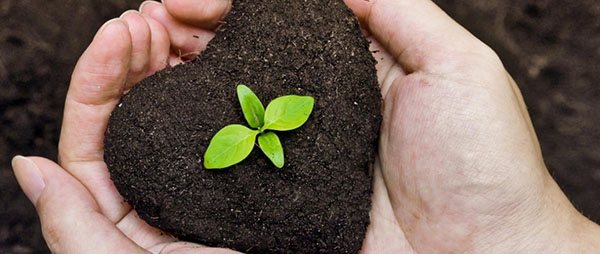

First, the hostess needs to decide what system she will use to grow spinach on the windowsill, either with or without a transplant. In the first case, a small container is used. After the emergence of shoots, the shoots dive to a permanent place. In the second option, it is better to take a flower pot or a shallow but wide vessel. The main thing is that there are drainage holes in it. The pot is filled in this way:
- the bottom is covered with expanded clay, gravel or broken brick (layer thickness 2-3 cm), then moisture will not stagnate in the lower part;
- mix vermicompost (1 part) and coconut fiber (2 hours);
- instead of the organic component, sometimes perlite or vermiculite is used (1-2 tsp are added per 1 m² of soil).
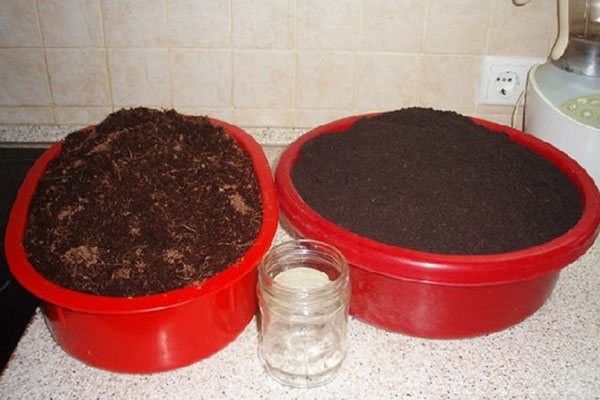

You cannot buy soil mixtures that include peat additives. This natural material oxidizes the soil and, according to scientists, promotes the leaching of vitamins from the plant.
One of the features of the soil substrate is the ability to retain moisture for a long period. However, in such an environment, organic matter begins to rot. To minimize the appearance of fungi and rot, housewives try to use rocks of volcanic origin.
Economy option
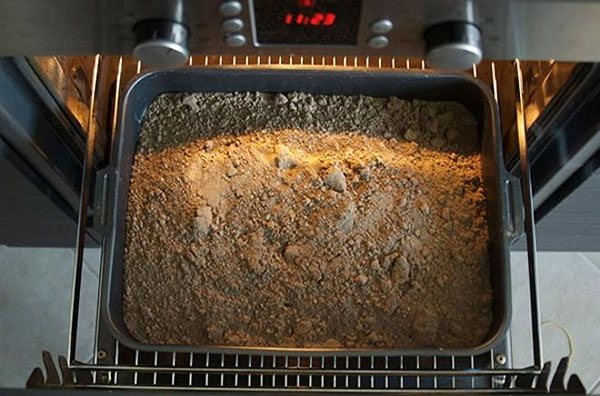

At the same time, many people practice using the following soil composition: garden soil, humus (cow or deciduous), and sand. The first component will need 2 parts, and the rest - one at a time.Before planting, the soil mixture is scalded with boiling water or disinfected with a solution, and then left for half an hour in the oven at 100 ° C.
For the most beneficial effect, the earth is pre-shed. Spread on a baking sheet. The layer thickness is up to 5 cm. Then the dishes are placed in the baking sleeve and sent to the oven. This serves as an effective disinfection method.
Preliminary preparation of seeds
Spinach seeds have a dense shell. If you plant them dry, then the seedlings will have to wait for a long time. To accelerate the emergence of seedlings, as well as to disinfect the seed, it is necessary to perform a set of measures:
- Sort out the material, reject small, dry nuts.
- During the day, they should be soaked in water at room temperature, changing it from time to time.
- Then, if necessary (if the material is your own, and was not purchased in a specialized store), the seeds are disinfected in a 1% solution of potassium permanganate.
- Dry slightly seed material, prepare for planting.


Some plant varieties (Victoria, Korenta) have very poor germination, the soaking time for them is extended to two days, and biostimulants are added to the water.
Care
When growing spinach in an apartment, it must be properly cared for. Like other crops, it requires a certain irrigation regime, air humidity and feeding. If this is neglected, the plants will die or the harvest will be very small.
Watering
To grow full-fledged spinach at home, it must be watered frequently and abundantly. This plant has an underdeveloped, superficial root system. Therefore, even with a slight drying out of the topsoil, spinach begins to suffer from a lack of moisture. For irrigation, use settled water at room temperature. Seedlings are watered strictly at the root. Wet leaves are often the cause of the spread of fungal diseases.
Air humidity
In an apartment or house, spinach can suffer from dry air. Its leaves become smaller, and flower arrows begin to form in the rosettes.
To prevent this, containers with water are placed next to it, the evaporating moisture increases the level of humidity in the surrounding air.
You can also close the heating radiator using a piece of dense cloth for this.
Useful information Daria Vorontsova Amateur gardener. He is fond of growing various greens at home. High humidity is the main secret when growing spinach at home. With a sufficient level of moisture, plants develop large rosettes of fleshy, well-developed leaves.
Top dressing
It is not recommended to feed spinach growing on the windowsill. All fertilizers are applied directly to the soil before planting. This is explained by the fact that spinach, like all green crops, is prone to the accumulation of nitrates contained in nitrogen fertilizers.
If there is an urgent need for feeding, humate can be used as fertilizer.
When properly cared for, spinach rarely suffers from pests and diseases. Strong, well-developed plants have a very high level of natural immunity.
If agricultural technology is not followed, spinach most often affects the following diseases:
- Powdery mildew. It appears as a white bloom. The massive spread of the disease is observed when coolness is combined with high humidity. To prevent its development, plants should be planted as rarely as possible and strictly adhere to the watering regime.
- Root rot. Most often it is a consequence of excessive watering in the absence of drainage. First, the lower leaves rot, then the plants die.
Useful information Daria Vorontsova Amateur gardener. He is fond of growing various greens at home. Home-grown spinach should not be chemically treated. Its greens will be unfit for human consumption.
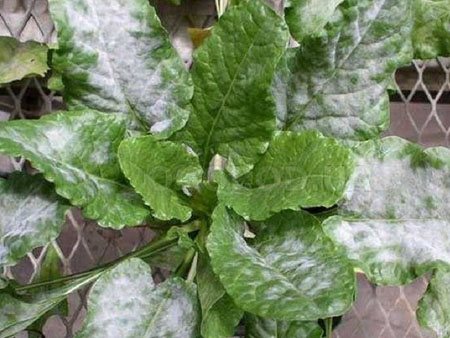

Powdery mildew


Root rot


Aphid


Whitefly
The most common pests on spinach are:
- Aphid. Small insects of green or black color. They feed on plant sap. To destroy it, it is recommended to wash spinach with a solution of ordinary laundry soap. If one treatment is not enough, repeat it after 5 days.
- Spider mite. A very small pest. Its presence can be determined by its characteristic cobweb bloom. Fighting it without the use of chemicals is useless. Infected plants are simply removed along with the root and destroyed.
- Whitefly. It actively feeds on leaf juice. With a small infection, you may not even notice it at first. Plants just stop growing a little. To destroy it, use special traps in the form of sheets with an adhesive layer.
Harvesting
3-4 weeks after sowing, the first greens will appear on the shrub. Mass harvesting can be done when the spinach grows to 7-10 cm and forms 5-6 large, dense leaves. It should be noted that at first the plant will develop very slowly, but after 20-25 days from the moment the shoots appear, the rosettes will grow rapidly. So, depending on the spinach variety, you can start cutting the leaves after 25-40 days.
The foliage must be cut with scissors or the leg must be carefully cracked. It is impossible to pull and tear out the plates, since this can harm the entire root system. You can harvest all the foliage at a time, leaving only very young leaves, but experienced farmers advise harvesting the plant as needed, since the leaves have a short shelf life - they wither during the day. The harvest itself must be carried out in the morning or evening hours.
During the growing season, leaves can be harvested from one shrub 4-5 times, and cutting can be carried out every 7-10 days. When the plant forms a flower arrow, it must be removed and, if desired, a new planting is carried out.
Spinach is an annual plant, so it doesn't take long to grow. After the appearance of the first greenery suitable for cutting, the bush will actively grow leaf plates for another 2 months, and after several scraps it will begin to release a peduncle, so its leaves will become unusable. So, in order to continuously get fresh spinach, it is worth sowing new batches of the plant every 2 months, and the old rosettes must be uprooted.
You can grow spinach at home at any time of the year. For this, the seeds of the plant must be sown in small low flowerpots, using nutrient soils for their rapid germination. Of course, getting a good harvest will also require proper care of the seedlings.
Usually, spinach is grown outdoors, but in order to get useful macro- and microelements even in the middle of winter, many sow spinach seeds at home and grow on a windowsill. If you can observe the easy rules of sowing and maintenance (create the necessary light and temperature conditions), then you will have fresh and juicy greens all year round, even if you do not have a summer cottage.
Agrotechnical cultivation
To sow spinach with seeds on the windowsill, it is necessary to prepare the seed, soil mixture and containers in which the greenery will be grown. The preparation of seeds involves soaking them for a day in warm water, and then for a few more hours in a solution of potassium permanganate - this procedure is needed to disinfect the material.
Next, you need to prepare the soil for growing crops. Spinach grows well in a light, nutritious and permeable soil mixture with neutral acidity, which can be prepared from 2 parts of coconut fiber and 1 part of vermicompost. When planting, it is imperative to use drainage, since the culture loves abundant watering, but at the same time stagnation of moisture is harmful for it.


When choosing a container in which you plan to plant spinach, immediately decide how the greens will be grown: in this very pot, or with subsequent picking into separate containers. If transplanting seedlings is not expected, then it is better to immediately take a large pot or plastic box. If young sprouts dive, then the capacity may be small, since excess plants will still be removed.
After the drainage is laid in the pot and the substrate is filled up, the seeds can be planted. Before sowing the seeds, the soil must be well moistened, then small depressions must be made in it, into which the planting material must be sealed by 1-1.5 cm. It should be borne in mind that each plant requires 8-10 cm of usable area. After sowing the seeds, the container is covered with glass until the first shoots appear.


Spinach is a cold-resistant plant and its seeds can germinate even at a temperature of +6 ° C, however, if the culture is kept on a windowsill, the optimum temperature is + 15-17 ° C. Under such conditions, the first shoots appear in about a week. When the plants have 2-3 leaves, they can be dived into separate pots.
Further cultivation of spinach greens on the windowsill is to create conditions that are as close to natural as possible. Illumination plays a big role in culture. If spinach is sown in spring, and the window on which it grows faces the sunny side, then we can assume that the light regime is provided for it. If the plants had to be planted in winter, additional lighting is indispensable. Artificial lighting in winter or cloudy time should be at least 2 hours a day.
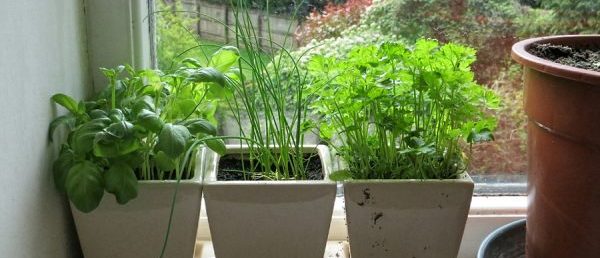

The temperature regime is no less important for the growth of greenery. Temperatures above 20 ° C accelerate the growth of the green mass and lead to the rapid release of the peduncle. To prevent this from happening, you must always maintain an optimal degree and monitor the humidity of the air. In indoor conditions, spinach should be sprayed with water daily, and in hot and dry periods, several times a day.


Benefits of spinach
The main plus of a vegetable is in preserving useful qualities, regardless of the method of preparation or preservation. Boiled, stewed, frozen spinach protects vitamins and minerals for us. This is important because the green leaves contain:
- vitamin C;
- carotene;
- vitamins B, D, K, P, E, PP;
- folic acid;
- amino acids;
- phosphorus;
- manganese;
- calcium;
- iodine;
- copper;
- iron;
- potassium in large quantities;
- sodium and others.
For a child, spinach is ground into gruel, since its leaves contain a "child" complex of vitamin D and mineral salts. They are essential for building bone mass and preventing rickets.
Recovery from complex diseases, especially of the digestive tract, is easier with the use of green leaves in their raw form.
It is important to remember that the beneficial properties of spinach can be offset by a high nitrate content. Before allowing a child or a person with a weakened body to eat spinach dishes, you need to check this indicator.
Spinach juice strengthens the nervous system, stimulates digestion, relieves constipation. Traditional healers make tinctures, which are used in addition to medicines in the treatment of anemia, flatulence, inflammatory processes, and respiratory diseases.
Like parsley and dill, spinach can be grown on your windowsill. But there will be more benefits from a vegetable than from greens. Use green leaves as a marinade for meat, seasoning, soups and independent dishes.
What do you choose? Have you tried growing spinach? What are the difficulties?
Growing seedlings


After the emergence of seedlings, the film is immediately removed, and the box is transferred to a well-lit place with a temperature of 18-20 ° C.
When growing spinach on a windowsill from seeds using the seedling method, the seedlings, after the development of a real leaf, dive into larger containers according to the 5 × 7 cm scheme or are planted in separate pots. Any containers of a suitable size can be used as them. For example, cut plastic bottles or dairy containers.
When using the seedless method, the plants are not transplanted, but only thinned out, leaving 2-3 cm between them first, then 5-7 cm each. The greens remaining after the second thinning can already be used for food. As a rule, these are already quite large plants with a height of 7-8 cm.
When growing spinach in an apartment, it must be properly cared for. Like other crops, it requires a certain irrigation regime, air humidity and feeding. If this is neglected, the plants will die or the harvest will be very small.
Watering
To grow full-fledged spinach at home, it must be watered frequently and abundantly. This plant has an underdeveloped, superficial root system. Therefore, even with a slight drying out of the topsoil, spinach begins to suffer from a lack of moisture. For irrigation, use settled water at room temperature. Seedlings are watered strictly at the root. Wet leaves are often the cause of the spread of fungal diseases.
Air humidity
In an apartment or house, spinach can suffer from dry air. Its leaves become smaller, and flower arrows begin to form in the rosettes.
To prevent this, containers with water are placed next to it, the evaporating moisture increases the level of humidity in the surrounding air.
You can also close the heating radiator using a piece of dense cloth for this.
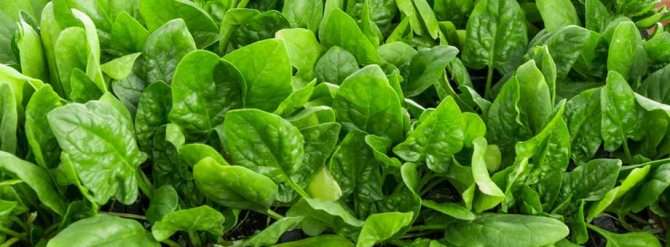

Top dressing
It is not recommended to feed spinach growing on the windowsill. All fertilizers are applied directly to the soil before planting. This is explained by the fact that spinach, like all green crops, is prone to the accumulation of nitrates contained in nitrogen fertilizers.
If there is an urgent need for feeding, humate can be used as fertilizer.
What to do: frequently asked questions
The spinach has sprouted well, but the sprouts are stretching upward. They do not give the first sheet, which should already appear.
Pulling out the sprouts indicates that the lighting is insufficient. Perhaps the window is directed to the north or east, too often cloudy weather, the day is not long enough. Either way, you'll need a fluorescent light to keep the spinach growing and thick enough.
What if the plant is growing very slowly? Its leaves are small and weak, so it is not possible to harvest a sufficient crop.
These signs indicate the poverty of the soil. It is required to add a fertile substrate or use special fertilizers.
The originality of green culture
Spinach is a rosette of glossy leaves. This is a heterosexual plant. There are male and female representatives of the vegetable. In male specimens, small and few leaves emerge from the sinuses. They are removed during thinning. Large, juicy leaves for cutting are given by females, they are left in the beds. Female specimens form nut seeds. Spinach roots are weak, growing 20 cm deep, which complicates the process of growing and care. The culture is also called a long day plant. As the day increases, peduncles appear, the leaves lose their juiciness, which is associated with an increase in the level of oxalic acid.
Popular varieties
The prevalence of the variety depends on the climatic conditions of the region. Popular spinach varieties:
- Strawberry
(berry) spinach is a vegetable with no special care requirements. In our latitudes, the variety "Strawberry Sticks" is more often planted with a weakly pronounced smell of strawberries and ruby-colored fruits. They eat not only fresh-sweet berries, but also leaves.The plant grows quickly, so salads with young spinach leaves and onions can be tasted in early spring. The berries ripen later - in June-August.
- Gigantic
the variety has a medium-sized rosette, with slightly raised, light green leaves. Fresh leaves are ground into gruel and added to baby food during the complementary feeding period. Great for canning. Harvest a month after germination, cutting off the rosette under the first leaf.
- Victoria
- a late-ripening variety with a small rosette pressed to the ground. The leaves are round, plastic, with pronounced pimples. From the moment the entrances appear until ripening, 20-40 days pass. The plant is light, weight does not exceed 30 g.
- Matador
- a hybrid plant that gives a good harvest. The leaves are smooth and oval than they resemble sorrel, but juicier. The color of the rosette is gray-green. The vegetable is frost-resistant, can hibernate under the snow, if the rosette has time to form. It develops longer than the mentioned varieties - 45-47 days.
- Fat-leaved
the variety ripens for 35-40 days. Leaves are smooth, with a weakly pronounced relief. The rosette is compact, no more than 17-30 cm in diameter.
Seed preparation and planting
Spinach seeds are quite large, and they germinate quickly and amicably, guaranteeing almost 100% germination. To achieve such results, they must be properly processed before sowing, adhering to the following instructions:
- The day before sowing, rinse the planting material, fill it with warm water and leave for 24 hours. This will accelerate its germination, as well as ensure uniform germination of young shoots.
- Drain the container in the morning. If earlier the seeds had a dense outer structure, then after soaking they slightly soak and swell.
- 2-3 hours before sowing, pour the seeds with a weak solution of potassium permanganate or potassium permanganate to disinfect them from diseases. Duration of soaking is 30 minutes.
- Dry the seedlings slightly and use for planting.
Spinach can be sown on seedlings or directly to a permanent growth site. In any case, before planting, the soil must be slightly moistened and grooves must be prepared, the depth of which is from 1 to 1.5 cm. The optimal distance between them is 2-3 cm. Throw spinach seeds into the prepared holes, and then cover them with soil.
Before emergence, the container should be covered with foil or glass. As a rule, seedlings hatch for 5-7 days.
How to sow spinach is clearly demonstrated in the following video:
Sowing
It is not necessary to germinate spinach seeds, they germinate well and without any pre-sowing preparation for 2 weeks. To accelerate germination, they can be soaked in warm water with the addition of a growth stimulant. For example, the well-known "Epin" or "Zircon" can be used.
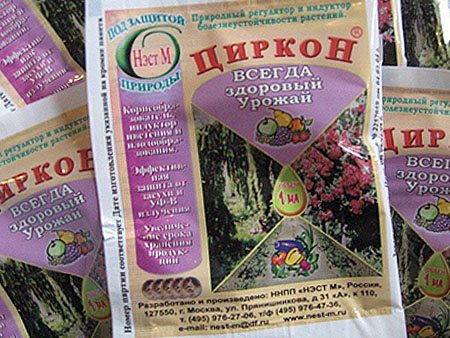

After about 2 days, they hatch. After that, sowing can begin. Step by step it looks like this:
- A 2-3 cm thick drainage layer is poured onto the bottom of the seed tank.
- The soil is laid on top of the drainage.
- On the soil surface, at a distance of 2-3 cm, parallel grooves are made with a depth of about 1.5 cm.
- The seeds are evenly distributed along the furrows and covered with soil.
- The land is watered abundantly with warm water.
- The container is covered with a piece of glass or film.
After the end of the sowing work, the box is placed in a warm place.
Features of soil preparation for sowing greenery
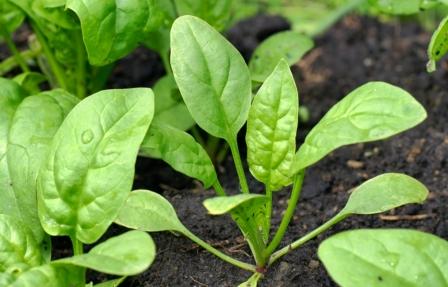

Spinach loves loose and nutritious soils, saturated with organic and mineral fertilizers, moisture and air permeable, well drained. You should start preparing a garden bed in the fall. Follow this sequence:
- Dig up the targeted area.
- Add organic matter (up to 8 kilograms per square meter), complex mineral fertilizer or superphosphate according to the instructions.
- Add urea before the snow melts.
- Cultivate the land in early spring.
- Add a bucket of humus per square meter of soil (if it didn't work out in the fall) and a glass of ash.
Keep in mind that nitrates in plant leaves accumulate quickly, therefore it is not recommended to use nitrogen fertilizers in spring and, in general, nitrogen fertilizers should be applied carefully.
Fertilizing spinach
Most often, fertilization is carried out in the autumn period, when the site is prepared for sowing. In the spring, just before sowing, fertilization with minerals is carried out (for soils with low fertility).
During the growth period, feeding is carried out when absolutely necessary.
The ways
Naturally, the dosage of the applied fertilizers should be combined with the level of soil fertility.
So, potash and phosphorus fertilizers are applied to fertile soil in the fall. At the same time, the soil is fertilized with humus or rotted manure. In this case, fertilizers are applied while digging the soil.
On less fertile soils, mineral fertilizers (potassium, phosphorus, nitrogen) should be applied immediately before sowing.
But with spring feeding, you should be careful, since the leaves accumulate chemical compounds introduced under the plant (for example, nitrates).
The better
Experienced gardeners prefer autumn soil fertilization. Indeed, during the winter period, she manages to assimilate the nutrients introduced as part of organic feeding. With the arrival of spring, such soil is already ready for cultivation.
Note: Since spinach is a fast-growing crop, it is not recommended to add fresh organic matter directly under it, because this is reflected in its taste.
During the growth period, it is also not recommended to feed with phosphorus and potassium fertilizers, which stimulate the shooting of the plant. And this is extremely undesirable for obtaining a high-quality harvest.
Sometimes there is a need for fertilizing with nitrogenous fertilizers. In this case, it is carried out together with watering. And yet, for such a top dressing there should be quite good reasons, since all substances absorbed from the soil are collected in the leaves of the culture, and it is they that are used for food.
Soil requirements
Spinach prefers fertile or well-fertilized soil. The plant is sensitive to both waterlogging and lack of moisture, as well as to the acidic reaction of the soil. Under unfavorable conditions, the growth of the plant slows down, it turns yellow and dies.
What should be
So what kind of soil should you choose? The best option would be loamy soil. Sandy requires frequent watering. Acidic soil needs to be calcified beforehand, but even then it will not be good enough due to the low content of the required amount of iron. And yet, whatever the soil was initially, it needs some care.
Soil care
Soil care begins with site selection. It should be sunlit and well-drained. In case of stagnant water in the soil, you will have to make a raised bed.


Figure 3. The procedure for growing in the open field
For the manufacture of such a bed, it is best to choose a material that does not rot under the influence of water (for example, cedar boards). Do not forget to ask about the acidity of the soil, because the culture prefers slightly acidic soils.
With increased acidity, liming of the soil should be carried out in advance (2-3 months before planting) by adding limestone to it.
To ensure that the soil is sufficiently saturated with nutrients, do not forget to add organic fertilizer (rotted manure, alfalfa and soy flour) to it.
The sown soil is mulched with leaves, hay or grass to stop the development of weeds, because the spinach sprouts are too fragile and pulling the weeds can damage the seedlings.
Be sure to spill the planted area. When doing this, remember that a strong jet of water can disrupt the order of the sown seeds or wash them out of the soil.Therefore, use a watering can or a spray nozzle on the hose.
The maximum yield is guaranteed on fertile sandy loam and loamy soils, well-drained and with neutral acidity. Under certain conditions, spinach gives good yields on other soils. So, sandy soil will have to be watered much more often, and to loosen heavy and dense soil, organic matter, lime and carbonate residues are needed.
A bed for spinach is arranged in a sunny place, since if there is insufficient lighting in the leaves, the amount of vitamin C is reduced. Soil preparation is divided into 2 stages:
- In the fall, you need to add compost to the selected area (per 1 m2 - 6 kg), and also feed the soil with phosphorus-potassium fertilizer, and then dig it up;
- In the spring, the site is cultivated, and if the soil is not fertile enough, then it is enriched with mineral dressing. Nitrogen is added only when absolutely necessary, since spinach leaves are sensitive to it and nitrates in them accumulate quickly.
Required inventory
To grow spinach on a windowsill, it must be sown in some kind of spacious container. For these purposes, you can use boxes or containers, the depth of which is not less than 15 cm. Seeds can also be sown in flower pots, but their volume should be at least 1 liter, but not more than 2 liters. In addition, when choosing a container, you should proceed from several parameters:
- will they fit on the windowsill;
- are there drain holes for water drainage;
- is it possible to prepare two layers - drainage (at least 3 cm) and ground (about 12-15 cm);
- whether it will be possible to maintain the optimal interval for planting seeds (for its calculation, the container should be divided into equal squares and see how many seeds can be sown).
Which varieties should you choose?
Varietal characteristics determine the early maturity and the amount of the future harvest, therefore, the choice of the variety must be approached with all responsibility. Experienced gardeners recommend taking a closer look at early-maturing varieties that yield an average of 30 days after sowing, have a good rosette and large fleshy leaves.
Based on these criteria, it is best to grow the following varieties at home:
- Victoria... Refers to a very early and early ripening leaf culture - after germination, the crop can be harvested in 25-30 days. The variety is characterized by rounded leaves (length - 8-10 cm), which are collected in a small rosette and pressed tightly to the ground. The petiole of "Victoria" is thick and short (length - 3.4-4.7 cm), and the mass of one plant is 25-28 g.
- Matador... It is a high-yielding hybrid that has oval leaves of dark green color (length - 18-22 cm) and a slightly raised rosette. After sowing the seeds, the plant will mature within 35-50 days. "Matador" is not afraid of frost and other unfavorable conditions, therefore it is often chosen for growing on balconies.
- Gigantic... The variety is distinguished by its delicate taste, so the foliage of the plant is often used in the preparation of various dishes for children. The crop can be harvested 21-23 days after the first shoots appear. The foliage of a delicate light green shade has an average size (length - about 20 cm) and forms a dense rosette, which is slightly raised.
- Fat-leaved... This early ripening variety ripens within 30-35 days after the first shoots appear. The green foliage of the plant has a fleshy structure, oval shape, embossed coating and an average length (18-20 cm). Numerous leaf plates form rosettes with a volume of 25-30 cm.
Each variety has its own characteristics. If it is difficult to make a choice, you can sow several packages of seeds of different varieties in separate containers. Once they are ripe, you can compare them and choose the type of spinach that works best for you.
It should be noted that the plant also comes in two types - common and New Zealand.Both spinach can be grown at home, but the second species will not quickly throw out the arrow and will give a more abundant green mass that can be harvested for 2-3 months.
Planting and care in the open field
Most often, a separate plot is not allocated for spinach, but is sown in the spring as a precursor to heat-loving vegetable crops, or in the summer after harvesting early vegetables. Sometimes the crop is grown as a sealant or as a lighthouse plant. And yet, it is better to give preference to the beds where cucumbers, tomatoes and greens were previously grown, because they are the best predecessors.
Although spinach is not a particularly whimsical plant, take care of the fertility of the soil: when digging, add humus (5 kg per 1 sq.m.) or ash (200 g per 1 sq.m.) into it. It would be best to carry out such a top dressing in the fall. If the soil has not been fed, you can add mineral fertilizers to it 2 weeks before sowing.
Note: In order to continuously obtain green products, the crop is sown at intervals of two weeks from mid-April to the end of August.
For autumn consumption, the crop is sown in June - July. The harvest from the August crops is harvested in early spring as a winter crop. In regions where the air temperature does not drop below -12 degrees in winter, the crop of spinach sown in autumn is harvested during the winter.
For the early emergence of seedlings, the seeds are pre-soaked for 1-2 days before they swell. Swollen seeds are sown in the prepared and moistened soil in rows.
So, on light soils, spinach is sown with multi-line ribbons, and on heavy soils, in a two-line method or across the bed. In this case, the seeds are planted to a depth of 4 cm (for loose soil), 2-3 cm (for heavy soil).
Seedling care consists in thinning, regular loosening of row spacings, weeding and watering. After the appearance of two true leaves, the sprouts are thinned at an interval of 10 cm 3-4 days after thinning, the crops can be fed with a solution of urea (5-10 g per bucket of water).
Harvested selectively, preferably in the morning. With continuous sowing, the greens are mowed in the phase of 4-5 true leaves.
The author of the video will tell you how to plant spinach seedlings in open ground.

